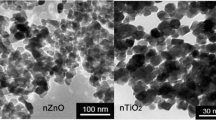Abstract
Zerovalent iron (ZVI) nanoparticles are gaining popularity in bioremediation of contaminated ground water and antimicrobial studies. In this study, ZVI nanoparticles were synthesized by borohydride method. The effect of these nanoparticles to alter the cell surface hydrophobicity of mangrove bacteria was studied by bacterial adhesion to hydrocarbon assay. The effect of these nanoparticles on the growth and extracellular polymeric substances (EPS) of a novel bacterial strain Halobacillus trueperi MXM-16 from mangroves was evaluated by growing the culture in the presence of ZVI nanoparticles and SEM. The change in the emulsifying ability of the cell-free supernatant of Halobacillus trueperi MXM-16 when grown in media amended with ZVI nanoparticles was also investigated by spectrophotometric analysis.





Similar content being viewed by others
References
Anderson BN, Ding AM et al (2007) Weak rolling adhesion enhances bacterial surface colonization. J Bacteriol 189:1794–1802
Araújo EA, Andrade NJ, da Silva LH et al (2012) Antimicrobial effects of silver nanoparticles against bacterial cells adhered to stainless steel surfaces. J Food Prot 75:701–705
Boxall ABA, Tiede K, Chaudhry Q (2007) Engineered nanomaterials in soils and water: how do they behave and could they pose a risk to human health. Nanomedicine 2:919–927
Buffat PH, Borel JP (1976) Size effect on the melting temperature of gold particles. Phys Rev A 13:2287
Cameotra SS, Dhanjal S (2010) Environmental nanotechnology: nanoparticles for bioremediation of toxic pollutants. In: Fulekar MH (ed) Bioremediation technology: recent advances. Springer, Netherlands, pp 348–374
Dehner C, Morales-Soto N, Behera RK et al (2013) Ferritin and ferrihydrite nanoparticles as iron sources for Pseudomonas aeruginosa. J Biol Inorg Chem 18:371–381
Dhas SP, Shiny PJ, Khan S, Mukherjee A, Chandrasekaran N (2014) Toxic behaviour of silver and zinc oxide nanoparticles on environmental microorganisms. J Basic Microbiol 54:916–927
Dickinson M, Scott TB (2010) The application of zerovalent iron nanoparticles for the remediation of uranium-contaminated waste effluents. J Hazard Mater 178:171–179
Dubois M, Gilles KA, Hamilton JK, Rebers PA, Smith F (1956) Colorimetric method for the determination of sugars and related substances. Anal Chem 28:350–356
Fulekar MH, Pathak B, Kale RR (2014) Nanotechnology: perspective for environmental sustainability. In: Fulekar MH, Pathak B, Kale RR (eds) Environment and Sustainable Development. Springer, India, pp 87–114
Huber DL (2005) Synthesis, properties and applications of iron nanoparticles. Small 1:482–501
Katsikogianni M, Missirlis YF (2004) Concise review of mechanisms of bacterial adhesion to biomaterials and of techniques used in estimating bacteria-material interactions. European Cells and Mater 8:37–57
Kharangate-Lad A, Bhosle S (2014) Siderophore producing halophilic and halotolerant bacteria adhered to mangrove plant litter. NeBIO 5:56–60
Kuhn KM, DuBois JL, Maurice PA (2014) Aerobic microbial Fe acquisition from ferrihydrite nanoparticles: effects of crystalline order, siderophores and alginate. Environ Sci Technol 48:8664–8670
Kumar M, Leon V, De Sisto-Materano A, Ilzins A (2006) Enhancement of oil degradation by co-culture of hydrocarbon degrading and biosurfactant producing bacteria. Pol J Microbiol 55:139–146
Kunkalekar RK, Prabhu MS, Naik MM, Salker AV (2014) Silver-doped manganese dioxide and trioxide nanoparticles inhibit both Gram positive and Gram negative pathogenic bacteria. Colloids Surf B: Biointerfaces 113:429–434
Mahdy SA, Raheed QJ, Kalaichelvan PT (2012) Antimicrobial activity of zerovalent iron nanoparticles. Int J Mod Eng Res 2:578–581
Rashmi SH, Madhu GM, Kittura AA, Suresh R (2013) Synthesis, characterization and application of zero valent iron nanoparticles for the removal of toxic metal hexavalent chromium [Cr(VI)] from aqueous solution. Int J Curr Eng Technol 1:37–42
Raza W, Hongsheng W, Qirong S (2010) Response of Paenibacillus polymyxa to iron: alternations in cellular chemical composition and the production of fusaricidin type antimicrobial compounds. Braz Arch Biol Technol 53:1145–1154
Rosenberg M, Gutnick D, Rosenberg E (1980) Adherence of bacteria to hydrocarbons: a simple method for measuring cell-surface hydrophobicity. FEMS Microbiol Lett 9:29–33
Sánchez JI, Martínez B, Guillén R, Jiménez-Díaz R, Rodríguez A (2006) Culture conditions determine the balance between two different exopolysaccharides produced by Lactobacillus pentosus LPS26. Appl Environ Microbiol 72:7495–7502
Senzaki T, Kumagai Y (1988) Treatment of 1,1,2,2-tetrachloroethane with iron powder. Kogyo Yosui 357:2–7
Tunquittiplakorn W, Cohen C, Lion LW (2005) Engineered polymeric nanoparticles for bioremediation of hydrophobic contaminants. Environ Sci Technol 39:1354–1358
Acknowledgment
The authors wish to thank Goa University for the financial grant given for doctoral studies and to NCAOR-Goa for the SEM facilities.
Author information
Authors and Affiliations
Corresponding author
Additional information
Responsible editor: Robert Duran
Electronic supplementary material
Below is the link to the electronic supplementary material.
Supplementary data 1
Partial sequencing of 16S rRNA gene of Halobacillus trueperi MXM-16 by Sanger's Method Supplementary data. (DOCX 10 kb)
Rights and permissions
About this article
Cite this article
Kharangate-Lad, A., Pereira, F., Fernandes, J. et al. Studies on the effects of zerovalent iron nanoparticles on bacteria from the mangrove ecosystem. Environ Sci Pollut Res 23, 927–931 (2016). https://doi.org/10.1007/s11356-015-5588-y
Received:
Accepted:
Published:
Issue Date:
DOI: https://doi.org/10.1007/s11356-015-5588-y




